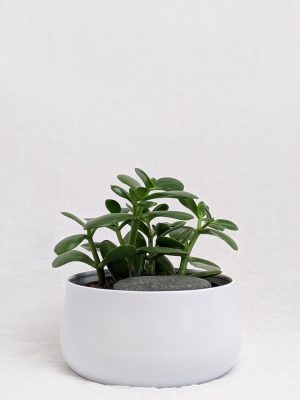Plant Care
Jade Plant Care
Jade plants are a type of succulent and they require minimal care, making them an excellent choice for new gardeners.
Light – Like all succulents and cacti, Jade Plants need bright light for most, if not all, of the day. They can handle direct sunlight, but too much direct afternoon light can result in scorching.
Water – Jade Plants store water in their thick, fleshy leaves, which allows them to go for long periods of time without water. How often you’ll need to water depends on the size of your plant. Older, larger plants can go for weeks or even months without water. Smaller plants will need water more frequently. Regardless of size, let the soil dry out completely and then thoroughly saturate it. Be careful not to over water Jade Plants as they can develop root rot. *Some potting soils may take a while to absorb water after being dry for a long period of time. This is referred to as becoming “hydrophobic” and can be overcome by repeatedly watering the soil and draining excess water, until the soil becomes saturated. *
Soil – Use a well-draining soil that doesn’t hold on to excessive moisture. A soil made for cacti and succulents like Espoma Cactus Mix is ideal, as it dries faster than traditional potting soils and doesn’t become hydrophobic as easily.
Temperature – Jade plants do best in temperatures between 60° and 75° and should not be exposed to temperatures below 50°. Protect from drafts, especially in winter.
Humidity – Unlike more tropical houseplants, Jade Plants prefer low humidity levels.
Fertilization – Jade Plants do not need to be fertilized often. Feeding every couple of months during spring, summer and fall with a cactus fertilizer, like Bonide Cactus Food, is sufficient. There is no need to fertilize during winter.
Size – While Jade Plants can reach up to 5 feet tall, they are extremely slow growing plants and it will take years, if not decades for it to reach that height.
Repotting – Due to their slow growing nature, Jape Plants don’t need to be repotted too often, usually every 2 to 3 years. Make sure to select a container with good drainage to prevent over watering.
Propagation – Like most succulents, Jade Plants are easily propagated by cuttings and leaves.
Toxicity – Moderately toxic to people and pets if ingested.



